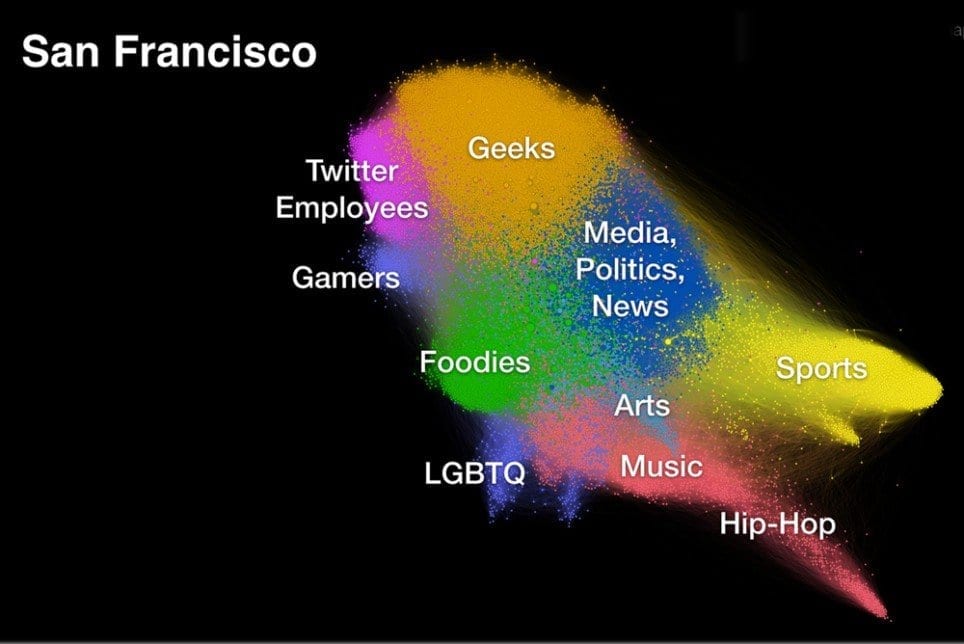Migration patterns into and out of cities are the result of millions of individual decisions, which in turn are affected by thousands of factors like economics, location, politics, security, aesthetics, sentiments and others.
However, it is becoming more and more critical for urban planners to be able to predict the rate of growth of a given city in order to better address future issues that arise from increasing urbanization. Publishing in the Journal of the Royal Society Interface, researchers from EPFL have discovered a law that could prove fundamental in forecasting the growth of cities.
Cities are often regarded as living organisms, bustling with life and activity. This metaphorical image has a real basis, as migration in and out of cities is a constant, dynamic force. But as cities boom across the world, it is becoming necessary to determine patterns in urban migration. This would allow the prediction of a city’s growth in the future, resulting in better planning for administration, design, logistics, and finance. The problem is that human migration over time and space is motivated by a vast range of individual decisions, giving rise to enormously complex data that are not easy to analyze.
An EPFL research team led by Alberto Hernando has discovered what may be universal laws underlying the seemingly random complexity of city movement. The team analyzed data records from the Spanish National Statistics Institute (INE), covering a period of 111 years (1900 – 2011) and including a total of 45 million people across 8100 municipalities in Spain. The team was able to view population flow in terms of Brownian motion – random movements of particles inside a medium, like dust floating in air. The exhaustive data available were critical for this innovative approach to work, and they allowed the researchers to uncover laws underlying city growth.
First, the way a city will grow in the future depends heavily on how it grew in the past. Although this seems intuitive, it is not always true since city growth depends on a multitude of factors. By using their model, the team found that it is possible to use past data to predict a city’s rate of growth, as long as that city has at least 10,000 inhabitants. They also found that this strong relationship between past and future lasts for approximately 15 years, during which it runs at a constant rate. What this means is that predictions of city growth require at least 15 years’ worth of population data for best accuracy.
Second, a city’s growth is strongly influenced by how neighboring cities grow. This is especially true when neighboring cities are within 80 Km; as the distance increases, the influence of neighboring cities weakens. This means that predictions of city growth would be challenging for cities like Las Vegas or Perth in Australia, which are large but relatively remote. The relationship between city growth and distance from neighbors means that geography is an important factor when forecasting the future urban sprawl of a particular city.
Following the model’s success, Hernando is now interested in extending it to isolate the factors that influence the movement of people.
The Latest Google Headlines on:
How cities grow
[google_news title=”” keyword=”How cities grow” num_posts=”10″ blurb_length=”0″ show_thumb=”left”]
The Latest Bing News on:
How cities grow
- As cities grow, the Internet of Things can help us get on top of the waste crisison April 26, 2024 at 2:17 am
Total global waste is expected to double from nearly 2 billion tonnes in 2016 to an estimated 4 billion tonnes by 2050 as consumer-oriented urban populations grow. As population growth increases ...
- 15 Fastest Growing Cities in Tennesseeon April 24, 2024 at 4:27 am
In this article, we will take a look at the 15 fastest growing cities in Tennessee. If you want to skip our discussion on the economy of the state, you can go directly to the 5 Fastest Growing ...
- 5 Fastest Growing Cities in Tennesseeon April 24, 2024 at 4:26 am
Piperton is at the third position on our list of the fastest growing cities in Tennessee. Living in Lebanon offers a small-town vibe with lots of family-friendly activities, such as visiting farms ...
- 5 Fastest Growing Cities in Tennesseeon April 24, 2024 at 4:26 am
the city’s median household income increased from $103,000 to $110,682, reflecting a growth of 7.46%. Piperton is at the third position on our list of the fastest growing cities in Tennessee.
- Supreme Court Will Rule On How States And Cities Can Respond To Homelessness Crisison April 21, 2024 at 5:00 am
Lower court decisions granting homeless people protections against cruel and unusual punishment could be reversed in a case brought by Grants Pass, Oregon.
- Here’s how much Michigan cities, counties made from marijuana sales in 2023on April 20, 2024 at 7:00 am
Michigan communities opted-in to adult-use marijuana sales were paid out their share of more than $87 million in revenue for 2023.
- Which cities are projected to grow more in the next decade?on April 18, 2024 at 5:00 pm
Recent Census data indicate several metro areas' populations are expected to grow by at least 50 percent from 2015 to 2040. Without peeking, can you identify those places? This quiz is not a ...
- Native Texas milkweed could help save the monarchs. Here's how to grow it.on April 13, 2024 at 4:00 am
More than 75 varieties of native asclepias grow along the monarchs’ migratory paths in North America, and more than 30 of them are indigenous in Texas.
- Top 10 Fastest Growing Cities in Texason March 30, 2024 at 12:14 pm
In this article, we list and discuss the Top 10 Fastest Growing Cities in Texas. If you would like to skip our detailed discussion of the topic, you can go directly to the Top 4 Fastest Growing Cities ...
- Top 10 Fastest Growing Cities in Texason March 30, 2024 at 9:14 am
In this article, we list and discuss the Top 10 Fastest Growing Cities in Texas. If you would like to skip our detailed discussion of the topic, you can go directly to the Top 4 Fastest Growing ...
The Latest Google Headlines on:
Growth of cities
[google_news title=”” keyword=”growth of cities” num_posts=”10″ blurb_length=”0″ show_thumb=”left”]
The Latest Bing News on:
Growth of cities
- Chinese City of Chengdu Relaxes Home-Buying Rule to Revive Saleson April 28, 2024 at 1:05 am
Chengdu, a major city in the southwest China, removed home-buying curbs, joining dozens of peers in the country in an attempt to revive real estate demand and boost economic growth.
- Dallas Increases Development Services Fees for First Time Since 2015 Amid City's Growth Surgeon April 27, 2024 at 2:00 pm
Dallas increases development service fees for the first time since 2015 to support city growth and administrative costs, effective May 1.
- City of Refuge, GROWTH Homes celebrate creation of five new homeson April 27, 2024 at 8:00 am
City of Refuge and GROWTH Homes have completed five new, single-family homes in Atlanta’s historic Westside neighborhood. These new builds mark a step in addressing the need for affordable ...
- Duluth mayor pledges population growth in the long-stalled cityon April 26, 2024 at 6:44 am
Mayor Roger Reinert said his goal is to grow the population of Duluth from about 87,000 to over 90,000 by the year 2030.
- Why Emma Stone Wants to Drop Her Stage Nameon April 25, 2024 at 6:46 pm
Emma Stone—whose real name is Emily Stone—recently shared that she would love to go by her birth name again, saying, "I would like to be Emily." ...
- Games and growth dominate Santa Clara’s State of the Cityon April 25, 2024 at 1:20 pm
In a State of the City speech that was a combination of a game show and a real estate listing presentation, Santa Clara Mayor Rick Rosenberg battled through a hoarse voice to give what was mostly an ...
- Hispanics at heart of population growth in Willistonon April 25, 2024 at 10:06 am
Williston officials say continued population growth will lead city to have to borrow money to support a major overhaul of the city’s infrastructure.
- Managing growthon April 25, 2024 at 4:00 am
Ankeny’s population has more than doubled since 2000. With more than 72,000 residents in 2022, it’s among the fastest-growing cities not only in Iowa but in the country. If that rate of growth ...
- Summerside facing challenges of growth, says mayor in state-of-city addresson April 24, 2024 at 10:55 am
"Our population has grown by over 10 per cent in just a few years," the mayor said. "Recently we have been add ...
- Seattle studied dozens of sites for housing growth. These 24 got pickedon April 17, 2024 at 6:01 am
The idea is about cultivating "15-minute" neighborhoods, where people can meet their basic needs by walking or biking from home, and spreading housing to areas where not much development has occurred ...











